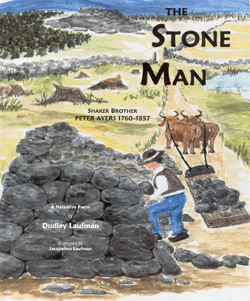|

The Stone Man
Dudley Laufman
ill. Jacqueline Laufman
By Alyce Wilson
Dudley Laufman's narrative poem, The Stone Man, tells the story
of Peter Ayers, a Revolutionary War veteran who moves to the Shaker
community of Niskeyuna, New York, where he becomes renowned for his
unflagging interest in clearing fields, simultaneously creating large
piles of rocks. These rock piles remain today, as photographs in the
back of the book attest.
The illustrations by Jacqueline Laufman are painted in a primitive
style reminiscent of folk art, a perfect match for the subject matter.
The 26-page book is the sort of fact-laden musing on history that would
sell well as a keepsake for visitors to the Canterbury Shaker Village.
Taken on its own merits, however, the poem is lackluster, partially
because it's written in the third person, as a factual, historical piece.
No one knows what drove Peter Ayers to create these rock piles. Such
insight would have been intriguing. Was it his personal therapy, a way
to cope with whatever he'd faced during wartime? Was it a personal compulsion
turned to private purpose? Was it his gift to the community who welcomed
him after the war?
The only time the poet enters Ayers' thoughts comes near the end, where
we're treated to a poem supposedly written by Ayers (but not attributed
to him in the credits, suggesting it is actually Dudley Laufman's creation.
In the poem, "The Swan", the speaker encounters a lonely swan,
who "swam towards me crying / Wings spread like a lover's arms
/ Just as the day was dying." After communing with the beautiful
bird, the speaker turns back "to my farm, cattle and sheep / Warm
stove and pets, / Pipe and dram and sleep." He imagines the swan,
on its ice enclosed lake, calling, "Come back / Come back, come
back."
This flight of fancy intrigues the reader far more than the bulk of
the poem, written in free-wheeling blank verse but sticking primarily
to prosaic language. As in this stanza:
The brothers said, We know, Peter, we know.
You're almost ninety-three and going strong.
But when you so desire, we've a place for you.
A little room higher than granite piles
Where you can see your art for miles around.
Perhaps the demands of the longer lines drowned and muted the poetic
fire the subject inspired.
Dudley Laufman's muse might have been loosed by writing in first person,
in shorter lines, which would not only be more appropriate for an American
folk story but also encourage the poet to enter Ayers' thoughts.
The Stone Man as it stands could make for an interesting keepsake.
Should Dudley Laufman engage in another such project, he should strive
to match poetic form to subject, trust his instincts and free his imagination.
Rating: *** (Good)
Canterbury Shaker Village Inc., 2005 (ISBN 0-913117-03-X)
|